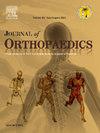将股四头肌角度作为严重膝关节骨性关节炎患者全膝关节置换术后结构完整性的结果测量指标
IF 1.5
Q3 ORTHOPEDICS
引用次数: 0
摘要
目的对于患有严重膝关节骨性关节炎(OA)的患者来说,常规的全膝关节置换术(TKA)可缓解疼痛并改善膝关节功能。股四头肌角度(Q 角)是膝关节稳定性的关键组成部分。本研究的目的是评估 Q 角作为 TKA 前后的结果测量指标,并找出 Q 角与严重膝关节 OA 患者 TKA 后疼痛、股四头肌力量和膝关节屈曲活动范围 (ROM) 的相关性。对疼痛、股四头肌力量和膝关节屈曲 ROM 进行了测量。结果TKA前的平均Q角为19.17°(SD = 1.92°),TKA后第六周为16.06°(SD = 1.87°),TKA后第三个月为13.43°(SD = 1.77°)。结论 采用标准化的临床动态关节角度测量方法测量了 TKA 前后的 Q 角。了解 TKA 手术前后的 Q 角及其与各种临床和功能变量之间的关系对于矫形外科医生和康复专业人员的临床实践至关重要。本文章由计算机程序翻译,如有差异,请以英文原文为准。
Quadriceps angle as an outcome measure for structural integrity following total knee arthroplasty in individuals with severe knee osteoarthritis
Purpose
Total knee arthroplasty (TKA) is routinely performed for pain relief and to improve performance of the knee in individuals with severe knee osteoarthritis (OA). The quadriceps angle (Q-angle) is a key component of knee joint stability. However, there is a dearth of literature evaluating Q-angle as an outcome measure after TKA in individuals with severe knee OA.
Objectives
The objective of the study was to assess the Q-angle as an outcome measure before and after TKA and to find the correlation of Q-angle with pain, quadriceps strength, and knee flexion range of motion (ROM) after TKA in individuals with severe knee OA.
Methods
The Q-angles of 34 individuals (male: female = 17:17) were measured using standardized procedures. Pain, quadriceps strength, and knee flexion ROM were measured. The measurements were taken preoperatively (one day before surgery), and postoperatively at the sixth week and third month after TKA.
Results
The mean Q-angle was 19.17° (SD = 1.92°) before TKA, 16.06° (SD = 1.87°) at the sixth week and 13.43° (SD = 1.77°) at the third month after TKA. Significant linear correlations were noted between the Q-angle and pain, quadriceps strength, and knee flexion ROM following TKA.
Conclusion
The Q-angle was measured before and after TKA using a standardized clinical goniometric method. Understanding the Q-angle before and after TKA and its relationship with various clinical and functional variables is imperative in clinical practice for orthopedic surgeons and rehabilitation professionals.
求助全文
通过发布文献求助,成功后即可免费获取论文全文。
去求助
来源期刊

Journal of orthopaedics
ORTHOPEDICS-
CiteScore
3.50
自引率
6.70%
发文量
202
审稿时长
56 days
期刊介绍:
Journal of Orthopaedics aims to be a leading journal in orthopaedics and contribute towards the improvement of quality of orthopedic health care. The journal publishes original research work and review articles related to different aspects of orthopaedics including Arthroplasty, Arthroscopy, Sports Medicine, Trauma, Spine and Spinal deformities, Pediatric orthopaedics, limb reconstruction procedures, hand surgery, and orthopaedic oncology. It also publishes articles on continuing education, health-related information, case reports and letters to the editor. It is requested to note that the journal has an international readership and all submissions should be aimed at specifying something about the setting in which the work was conducted. Authors must also provide any specific reasons for the research and also provide an elaborate description of the results.
 求助内容:
求助内容: 应助结果提醒方式:
应助结果提醒方式:


